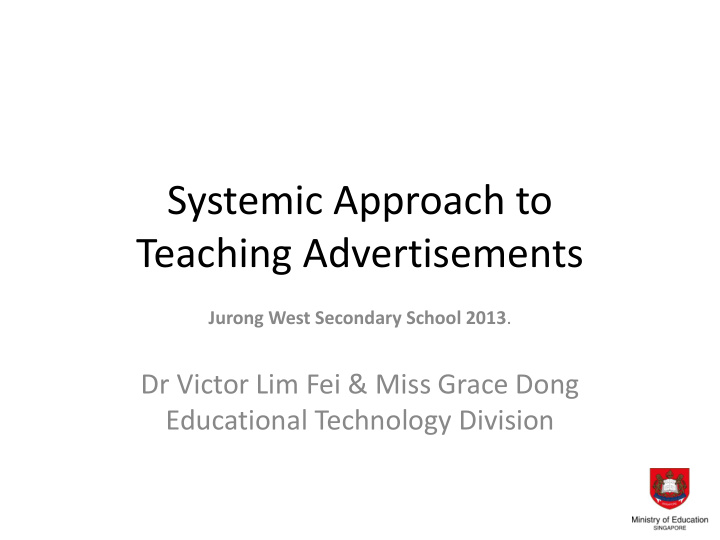



Systemic Approach to Teaching Advertisements Jurong West Secondary School 2013 . Dr Victor Lim Fei & Miss Grace Dong Educational Technology Division
Multimodal Literacy • The multimodal approach takes into account how linguistic and visual (and other) choices fulfill the purposes of the text, the audience and context, and how those choices work together in the organisation and development of information and ideas. • From there, students can understand and develop appropriate strategies for writing and creating effective texts.
Multimodal Literacy • This pedagogical approach stems from Michael Halliday’s Systemic Functional Theory. • The Systemic Approach is an extension to the teaching and learning of media messages • Developed jointly by researchers from the Multimodal Analysis Lab, National University of Singapore and specialists from Educational Technology Division, Ministry of Education.
Multimodal Literacy Current research in multimodal analysis establishes the need and provides the meta- knowledge to develop multimodal literacy in education. (for example, Jewitt, 2007, 2008, 2009; Kress, 2003; Kress, Jewitt, Bourne, Franks, Hardcastle, Jones, Reid, 2005; Lim, O’Halloran & Podlasov, in print; O’Halloran, 2004; O'Halloran & Smith, 2011; O’Halloran, Podlasov, Chua, Tisse & Lim, in print; Ventola & Guijarro, 2009).
Multimodal Literacy “a ‘ multimodal literate ’ student must be sensitised to the meaning potential and choices afforded in the production of the text, rendering an enhanced ability to make deliberate and effective choices in the representation of knowledge .” O’Halloran and Lim (2011)
Intuitive Approach • ‘Disenfranchising’ • If ‘you don’t get it, you won’t get it’
Systemic Approach • Identify linguistic and visual choices made through knowledge of meta-language • Map choices to the meanings and ideologies • Move from description and subjective interpretation to analysis and interpretation • Grounded in textual evidence • Develop analytical capability and cultivates critical thinking
T&L Implications of the Systemic Approach • Meanings in texts are a result of specific choices made within systems • Provides a set of vocabulary for teachers & students to describe the choices • Supports interpretations with textual evidences • Empowers students’ perspectives
System Choices for Advertisements
Textual Meta-function Design System (Compositional) Interpersonal Meta-function Attraction System (Engagement) MEANING Appeal System Ideational Meta-function (Informational) Representation System
Design (Visual) • Main Visual Display: largest & most prominent • Focus of Attention: stands out most • Logo: graphic representation of company • Icons/Symbols: graphic representation of idea • Graphic Text: letter shapes & words • Visual Puns: visual shape of concept & ideas
Design (Language) • Headline: largest & most prominent text: • Slogan: memorable catch-phrase • Brand Name: name of brand, company • Product Name: name of product • Main Text: details & description • Lists/sub-categories: bulleted points • Call to action: command to do something • Call & visit information: contact details
FOA MVD ICON
Headline Product Name Call & Visit Info Slogan Call to Main Text Action Brand Name
Graphic Text
Visual Pun
Visual Pun
Size Sharpness Prominence Colour Contrast Lighting Foregrounding Direct Gaze Attraction Address Indirect Gaze No Gaze High Angle Power Low Angle Eye Level Close Shot Distance Medium Shot Long Shot
Size Sharpness Attraction Prominence Colour Contrast Lighting Foregrounding
Prominence: Size
Prominence: Contrast (Black & White)
Prominence: Colour Contrast
Direct Gaze Address Indirect Gaze Attraction No Gaze
Address: Direct Gaze
Address: Indirect Gaze
Address: No Gaze
Close Shot Attraction Distance Medium Shot Long Shot
Distance: Close Up
Distance: Extreme Close Up
Distance: Long Shot
High Angle Power Low Angle Attraction Eye Level
Power: High Angle
Power: Low Angle
Denotative Meaning Representation Connotative Meaning
Authority Popularity Individuality Appeal Status Beauty Intelligence Duty Others…
Appeal to Authority
Appeal to Popularity
Appeal to Uniqueness
Appeal to Status
Appeal to Beauty
Appeal to Intelligence
Appeal to Parental Duty
Co-contexualising Relations Reinforcement (Semantic Convergence) Interaction of Language & Images Play : Sarcasm, Irony, Wit Re-contextualising Relations (Semantic Divergence) Breakdown : Ambivalence, Confusion
Balance Photo by Zachary Tan
Introduction of Selected System Choices • Teacher introduces: • how to identify system choices • possible interpretations of each design elements Pre-Annotation: Personal Response to Selected Text • Teacher elicits responses (personal) w.r.t. text from class Annotation: Making sense of Selected Text • Students annotate text using a structured worksheet to guide their analysis • Students discuss their interpretation as a pair/group Post-discussion • Students present their interpretations to the class • Teacher facilitates a discussion on meanings made, links between ideas and embedded social values in the advertisement
Pre-Annotation: Personal Response to Selected Text 1) What does the advertisement aim to communicate? 2) What interesting things do you notice about the advertisement? • Why foreground personal response? – empowering students’ responses • Teachers ≠ oracle – gauging student prior knowledge
• (Collective) response made visible – suggestion: to note all responses on whiteboard (exploratory talk: w/o value judgement, interesting points could be pursued/clarified) – reference point for annotation exercise – collation of divergent views
Annotation: Making sense of Selected Text
Annotation: Making sense of Selected Text • Identify system choice elements – Deliberate choices • Effect on audience – Provide evidence and anchor to these interpretations • Links: – immediate connections to previously cited points to
4. Drawing the ideas together from part 3, write a paragraph about what the advertisement seeks to communicate? Provide evidence for your interpretation. • Reorganisation, persuasion, synthesis of ideas
Discussion about embedded social values • one or two points of interest identified earlier: debate • advertisement relates and communicates certain values held by society • needs questioning?
Technologies
Systems (the ‘grammar’) Systems organised may be edited and new into catalogs for different text types and genres systems created
Systems (‘grammar’) Systems organised may be edited and new into catalogs for different text types and genres systems created
Toolbar Text Types
Toolbar Text Types
Toolbar Text Types
Catalog Annotations Overlay Panel Choice System System Choices Drawing Justification Tools Description Overlay
Multimodal Literacy Learning Community
victor_lim@moe.gov.sg grace_dong@moe.gov.sg
Recommend
More recommend